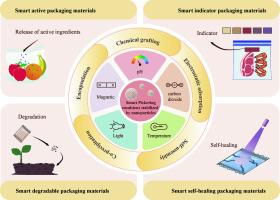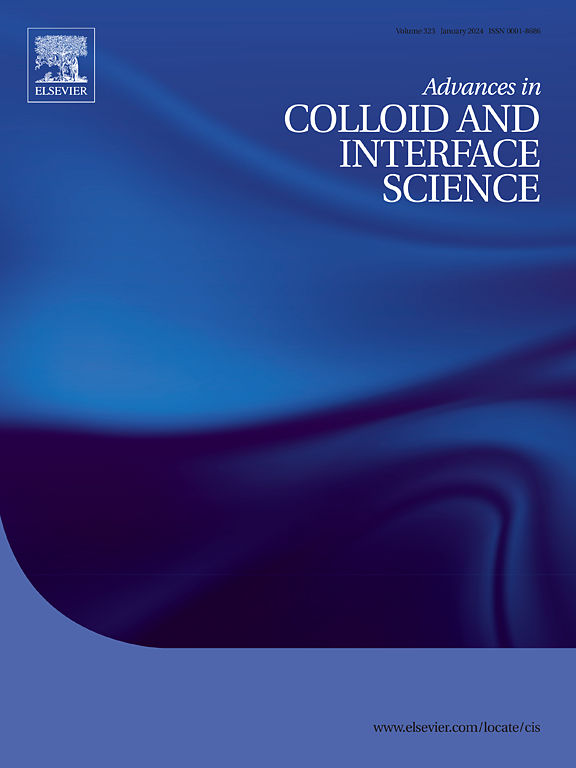智能皮克林乳液稳定功能化纳米颗粒:创新应用在先进的食品包装。
IF 19.3
1区 化学
Q1 CHEMISTRY, PHYSICAL
引用次数: 0
摘要
皮克林乳液(pe)是一种由固体颗粒稳定的分散体,具有优异的稳定性和对环境敏感活性成分的有效包封和保护能力。固体颗粒在保证乳剂的稳定性和功能性方面起着至关重要的作用。具有刺激响应的智能pe可以响应外部刺激,如pH, CO2,温度,光和磁,以调节乳液的稳定性(乳化或破乳),并智能控制被封装的活性成分的释放,使其在多个行业中具有很高的价值,特别是在高级包装材料的制备中。但传统的固体颗粒不能赋予其对pe的刺激反应能力。因此,表面功能化成为引入纳米颗粒作为智能聚乙烯稳定剂的刺激响应性的基本方法。本文介绍了pe的稳定机理和影响因素,总结了纳米颗粒对智能pe的刺激响应机制,重点介绍了功能化引入纳米颗粒刺激响应的方法。采用化学接枝、静电吸附、自组装、共沉淀法和包封等方法对纳米颗粒进行表面改性取得了显著进展。同时介绍了智能聚乙烯在活性包装、指示包装、自修复包装、可降解包装等方面的应用。概述了智能聚乙烯应用于先进包装材料的当前挑战和未来方向。这些见解对于优化智能pe的功能和扩大其在各个领域的应用潜力具有不可估量的价值。本文章由计算机程序翻译,如有差异,请以英文原文为准。

Smart Pickering emulsions stabilized by functionalized nanoparticles: Innovative applications in advanced food packaging
Pickering emulsions (PEs) are dispersions stabilized by solid particles, have excellent stability and the ability to efficiently encapsulate and protect active ingredients sensitive to environment. Solid particles play a critical role in ensuring the stability and functionality of emulsions. Smart PEs with stimuli-responsive can respond to external stimuli such as pH, CO2, temperature, light and magnetism to regulate the stability of the emulsion (emulsification or demulsification) and smartly control the release of the encapsulated active ingredient, making them highly valued across multiple industries, exceptionally in the preparation of advanced packaging materials. But conventional solid particles cannot endow the ability with stimuli-response to PEs. As a result, surface functionalization emerges as an essential approach for introducing stimuli responsiveness for nanoparticles as stabilizers of Smart PEs. This review introduces the stabilization mechanism and influencing factors of PEs, summarizes the stimuli-responsive mechanisms of nanoparticles for smart PEs and focus on functionalization employed to introduce stimuli responsiveness for nanoparticles. There has been a significant advance in surface modification of nanoparticles, employing the approaches of chemical grafting, electrostatic adsorption, self-assembly, co-precipitation and encapsulation. Meanwhile, the applications of smart PEs in active packaging, indicator packaging, self-healing packaging, and degradable packaging are presented. The current challenges and future directions of smart PEs applying to advanced packaging materials are also outlined. These insights will be invaluable for optimizing functions of smart PEs and broadening their application potential across various fields.
求助全文
通过发布文献求助,成功后即可免费获取论文全文。
去求助
来源期刊
CiteScore
28.50
自引率
2.60%
发文量
175
审稿时长
31 days
期刊介绍:
"Advances in Colloid and Interface Science" is an international journal that focuses on experimental and theoretical developments in interfacial and colloidal phenomena. The journal covers a wide range of disciplines including biology, chemistry, physics, and technology.
The journal accepts review articles on any topic within the scope of colloid and interface science. These articles should provide an in-depth analysis of the subject matter, offering a critical review of the current state of the field. The author's informed opinion on the topic should also be included. The manuscript should compare and contrast ideas found in the reviewed literature and address the limitations of these ideas.
Typically, the articles published in this journal are written by recognized experts in the field.

 求助内容:
求助内容: 应助结果提醒方式:
应助结果提醒方式:


